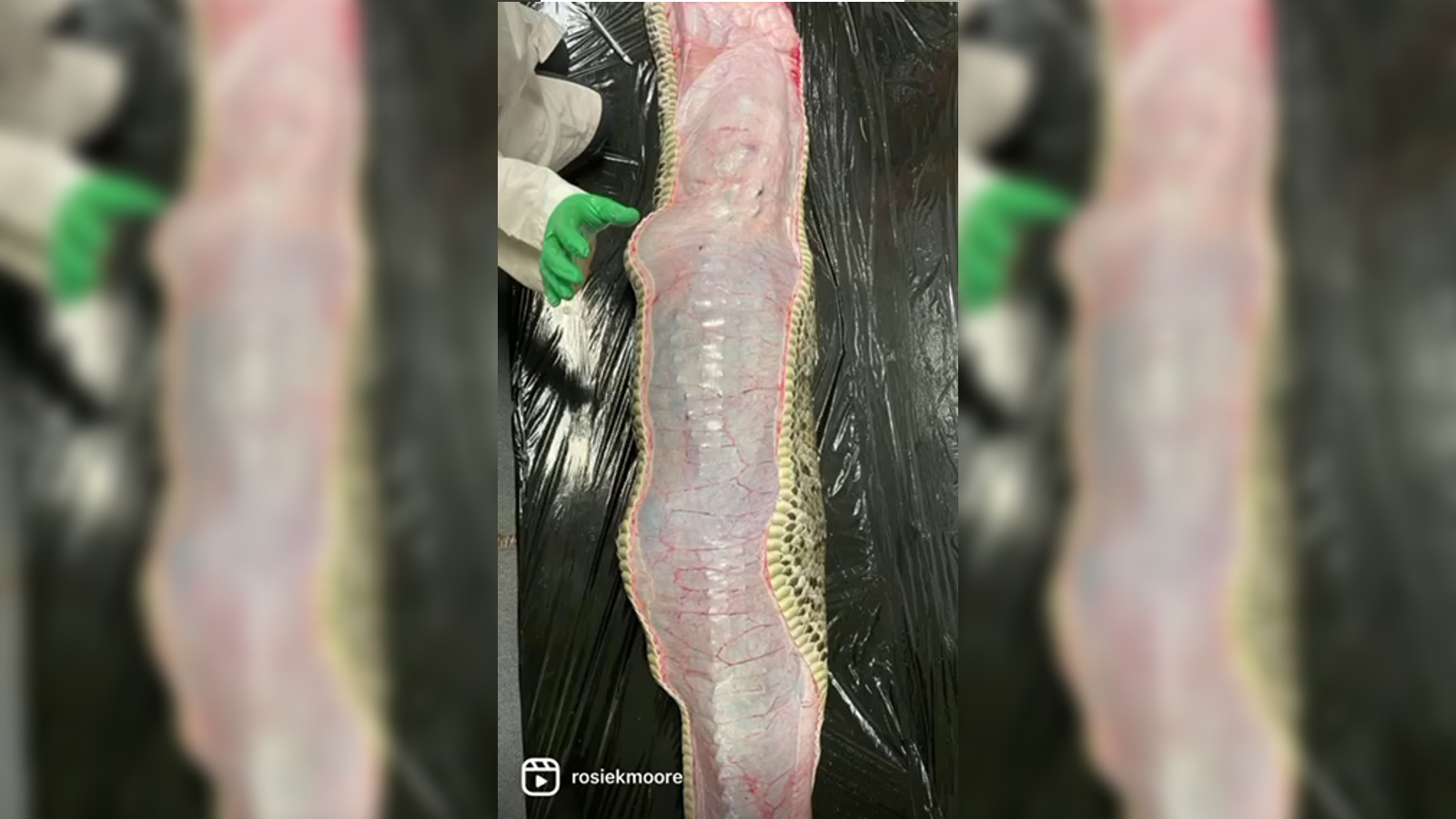Gruesome video reveals the moment a 5-foot alligator corpse was cut from the gut of a dead python
In a viral Instagram video, pathologists remove a dead 5-foot alligator from the body of an 18-foot Burmese python.
A team of veterinary pathologists recently extracted a 5-foot-long (1.5 meters) alligator corpse from the body of an 18-foot (5.5 m) Burmese python that was euthanized in Florida. The necropsy, or animal autopsy, was captured in a jaw-dropping video and recently went viral on Instagram.
The chunky python was the same length as Florida's largest-ever Burmese python (Python bivittatus), which was caught and killed in June. That individual weighed around 215 pounds (97 kilograms), but the newly-dissected python was likely even heavier at the time of death, considering its massive final meal.
A group of biologists discovered the alligator-stuffed snake in Everglades National Park. The scientists were surveying invasive plant species when they came across the enormous serpent, which is also invasive to Florida. The researchers swiftly euthanized the snake in accordance with local wildlife guidelines and sent it to a Florida-based laboratory for a necropsy. (As Burmese pythons are an invasive species and threaten local wildlife, people may capture or kill them humanely year-round in certain parts of south Florida without requiring a hunting permit or license to do so, according to the Florida Fish and Wildlife Conservation Commission.)
Rosie Moore, a Florida-based geoscientist who also studies invasive herpetofauna — reptiles and amphibians — and was part of the necropsy team, posted a video of the gory operation on her Instagram account on Nov. 1. In the video, the pathologists cut open the snake's skin and then its stomach before sliding the dead gator out of its slimy pink tomb. At the time of publication, the video has been viewed more than 16.8 million times and had around 395,000 likes.
Related: Watch a python swallow an impala whole in this jaw-dropping video
"When it arrived at the lab, it was apparent that there was an alligator inside the python," Moore told Live Science in an email. The team removed the gator from inside the snake so they could measure it, she added.
The swallowed gator was in such good condition that it looked like it could have stood up and walked out of the room, which surprised the researchers who freed it. "The python had begun to digest the gator, but for the most part, the gator was fully intact," Moore said. The only visible damage was done to the dermal layer, or scales, she added.
Get the world’s most fascinating discoveries delivered straight to your inbox.
This is not the first time that a Burmese python has swallowed an alligator whole, but it is unclear how common that is, Moore said. "While reports have been growing of python-gator predation and vice versa, I would not precisely characterize it as a common occurrence." Typically, the enormous snakes prefer to target other types of reptiles, as well as birds, rodents and other small mammals, she added.
It is commonly and falsely assumed that pythons and other large snakes, like anacondas, are able to swallow massive prey — such as alligators, deer and even humans — by dislocating their jaws. But in reality, snakes' jaws do not dislocate. Instead, their upper and lower jaws are connected by a super-stretchy piece of elastic tissue that gives them "a great deal of mobility," Moore said.
In August, a new study tested how wide Burmese pythons' gape can reach and revealed that the largest individuals, like this one, could potentially stretch their jaws up to 30 inches (76 centimeters) wide.
Burmese pythons were introduced in Florida in the early 1970s when pet owners illegally released them into the wild, Moore said. The hardy serpents have since "exploded" in numbers and caused widespread damage to animal populations in Everglades National Park, she added. Since the python's arrival, up to 99.3% of raccoons, 98.9 % of opossums and up to 87.5% of bobcats have been wiped out in the park's southernmost regions, according to the U.S. Geological Survey.
"Due to these impacts, it is highly encouraged that Burmese pythons are euthanized on sight," Moore said.

Harry is a U.K.-based senior staff writer at Live Science. He studied marine biology at the University of Exeter before training to become a journalist. He covers a wide range of topics including space exploration, planetary science, space weather, climate change, animal behavior and paleontology. His recent work on the solar maximum won "best space submission" at the 2024 Aerospace Media Awards and was shortlisted in the "top scoop" category at the NCTJ Awards for Excellence in 2023. He also writes Live Science's weekly Earth from space series.





